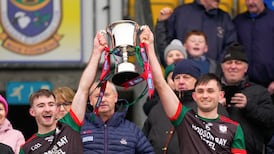Did the coronavirus crisis reshape the GAA or allow certain intrinsic strengths to emerge? What will be the lasting impact on the games or their place in society?
With 2021 looking in many ways even more challenging than last year, it’s probably a bit early to write the history of the association’s fortunes during the pandemic.
In fairness to the authors, NUI Galway’s Dr Seán Crosson and Mary Immaculate College’s Dr Marcus Free, This Too Shall Pass: Gaelic Games, Irish Media and the Covid-19 Lockdown in Ireland, they weren’t attempting a comprehensive account of the past 12 months but rather highlighting significant themes that emerged during the first wave.
Their essay is one in an interesting collection, 'Time Out: National Perspectives on Sport and the Covid-19 Lockdown,' [available at $25, https://bit.ly/36F7iSZ] which examines the impact of Covid-19 on sport across a broad range of countries and sports.
For the Irish chapter Dr Crosson, an authority on sport, especially Gaelic games, on film and Dr Free, who specialises in sport’s relationship with society and media, focus on how the GAA’s interaction with media, particularly broadcast, helped project an image of the association during lockdown.
For the period covered it’s a familiar narrative of how the association emphasised its value to the community both in the acts of volunteerism at local level and measured responsibility on the national stage, as exemplified by president, John Horan’s reassurance and caution in interviews on RTÉ, especially the Sunday Game.
“While, ordinarily the GAA is subjected to extensive critical commentary,” the essay observes, “especially for the near-professionalism, costs of preparation of the elite intercounty teams, and consequent internal divisions, coverage of the organisation during the lockdown was overwhelmingly presented as uniquely emblematic of a collective national effort, bringing out the ‘best’ in ‘us’.”
The point is further emphasised: “Media narratives of heroic frontline service and charitable and pedagogical work by GAA athletes were widely interspersed with celebrations of Gaelic games’ cultural value.”
Two dominant themes of media coverage of the association are cited.
“Firstly, there was a recurring focus on the serious impact on the GAA, its athletes, and national sports media of the cancellation of its elite and local level events over its peak spring-summer season.
“. . . a second major theme was the GAA’s key role in responding to the crisis and in articulating a discourse of overcoming, both in terms of the association’s challenges and wider Irish society.”
The first theme is probably a necessary one given the demand or interest – even now – of stakeholders, including players and managers that concrete details of or signposts to a return to play be forthcoming but too much attention to the nuts and bolts of the pandemic has a downside, as the essay from the Philippines (‘Filling the Sports Page with Nostalgia in a Pandemic-Abbreviated Season,’ by Severino R Sarmenta Jr) notes.
Elevated reputation
“But the pandemic story by itself posed the possibility of causing ‘story fatigue,’ or a weariness among readers on a subject that crept into the sports pages. The sports page has often been a refuge to find alternatives to the content of the front pages or headlines.”
This may have been necessary public relations work but the theme of the GAA representing society has been a more comforting one.
It would have been interesting though to get the authors’ views on and analysis of an expanded frame of the calendar year because their focus runs from the beginning of the lockdown in March until May 10th, the threshold of the summer, which would see a return to play, and as they were aware by that stage, the prioritisation of the club calendar.
An extra few months would have raised very different coverage, which complicated the hitherto elevated reputation of the games.
The GAA’s image ran into trouble in the autumn with the heedless celebrations, which took place in some parishes after county final victories. Croke Park did move to halt the whole process in October and as a result, some championships remain incomplete but at least some reputational damage had been done.
There was a sense that the plug might have been pulled a week earlier or even that the likely consequences of triumphant teams in conjunction with the by then open ‘wet bars’ might have been anticipated.
In the event the very public association of club and parish successes with coronavirus outbreaks became an unhelpful counter to the earlier image of the GAA and its communities being at one with the national interest.
Unfortunately this was the flip side of local enthusiasms, which as surely as they look after the vulnerable in society, in many cases threw caution to the wind when celebrating their successes. It’s a dichotomy with which the GAA is familiar.
An extended period of review would also have brought to the fore the importance of the association’s Covid Advisory Group, which had only been established in May and attracts only fleeting attention.
There’s no doubt that the medical experts on this body were hugely influential in navigating the safe return to play last summer – just as they have been voices of restraint in current deliberations.
The GAA ultimately emerged from 2020 with a good deal of credit, having guided to a conclusion two All-Ireland championships by the end of the year despite the absence of crowds and the consequent financial difficulties.
A further underlining of the impact of the association’s successful self-projection came in the allocation of public funds to subsidise the running of the championships – with it, recognition that the games are indeed symbolically important to the nation.
It’s always positive to have the GAA and its activities put under the spotlight by eminent academics and placed in an international context. If we ever get out of this, it would be fascinating to see what the authors would make of the completed experience.















